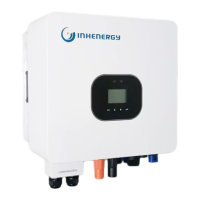How to fix 'N-PE Fault!' on INHENERGY HI-3K-SL?
- JJessica YoungAug 29, 2025
If your INHENERGY Inverter displays 'N-PE Fault!', check if the L line and N line are reversed and ensure the PE is properly connected.

How to fix 'N-PE Fault!' on INHENERGY HI-3K-SL?
If your INHENERGY Inverter displays 'N-PE Fault!', check if the L line and N line are reversed and ensure the PE is properly connected.
Why does my INHENERGY HI-3K-SL say 'No AC Input'?
If your INHENERGY Inverter displays 'No AC Input', take the following steps: 1. Confirm whether the grid is lost. 2. Check if the grid connection is properly established. 3. Ensure that all switches on the cable are turned on.
What does 'Battery Open' mean on my INHENERGY HI-3K-SL Inverter and how to fix it?
If your INHENERGY Inverter shows 'Battery Open', verify that: * The battery connection is secure. * All switches between the battery and the inverter are turned on.
How to troubleshoot 'Bat Volt Low' error on INHENERGY HI-3K-SL Inverter?
If you see 'Bat Volt Low' on your INHENERGY Inverter, check the battery's actual voltage and ensure the wiring between the battery and inverter is in good condition.
What to do if my INHENERGY HI-3K-SL says 'Bat Need Chg'?
If your INHENERGY Inverter displays 'Bat Need Chg', you can resolve it by: 1. Setting the battery stop discharge SOC to a higher value. 2. Charging the battery properly.
How to fix 'Bat Reversed' error on INHENERGY Inverter?
If your INHENERGY Inverter displays 'Bat Reversed', verify that the positive and negative terminals of the battery are correctly connected.
What does 'AC Volt Out' mean on my INHENERGY Inverter and how do I resolve it?
If your INHENERGY Inverter shows 'AC Volt Out', check that the AC voltage is within the standard voltage range specified and ensure the grid connection is secure.
What to do if my INHENERGY HI-3K-SL Inverter displays 'AC Freq Out'?
If your INHENERGY Inverter displays 'AC Freq Out', check that the frequency is within the specified range. You may also try restarting the inverter. Contact the manufacturer if the issue persists after restarting.
How to troubleshoot 'BatVolt High' error on INHENERGY HI-3K-SL?
If your INHENERGY Inverter displays 'BatVolt High', check if the battery voltage is within the specified range and that the battery connection is correct. If the battery voltage exceeds 60V, disconnect the battery and inspect the inverter.
What to do if my INHENERGY HI-3K-SL Inverter shows 'EPS Volt Low'?
If your INHENERGY Inverter displays 'EPS Volt Low', check the load on the Back-Up. If an overload has occurred, reduce the load. You can also try restarting the inverter.
| Max. DC Input Voltage | 550 V |
|---|---|
| Nominal AC Output Power | 3000 W |
| Max. AC Output Power | 3300 W |
| Nominal AC Voltage | 230 V |
| Max. Output Current | 15 A |
| Efficiency | 97.5% |
| Protection Degree | IP65 |
| Output Power | 3000 W |
| Peak Power | 3300 W |
| Output Voltage | 230 V |
| Frequency | 50/60 Hz |
| Cooling | Natural Convection |
| Max. DC Input Power | 4500 W |
| MPPT Voltage Range | 125-500 V |
| Input Voltage | 125V-500V |
| Protection Features | Overvoltage, Short Circuit |
| Operating Temperature | -25°C to 60°C |
Details the function and features of the hybrid inverter series.
Specifies the inverter models covered and the target audience for the manual.
Explains safety symbols used in the manual to prevent injury or damage.
Instructions for checking the inverter for damage incurred during transportation.
Details the items included in the inverter package for verification.
Provides conditions and precautions for installing the inverter outdoors.
Specifies the minimum clearance dimensions required around the inverter for installation.
Step-by-step guide for physically mounting the inverter onto a wall bracket.
Details how to connect photovoltaic (PV) panels to the inverter's DC inputs.
Explains the procedure for connecting batteries to the inverter, including cable requirements.
Covers the connection procedures for grid, generator, and backup power sources.
Describes how to properly ground the inverter for safety.
Details the connection of communication ports for monitoring and data exchange.
Explains the connection and function of the CT1 port for current sensing.
Details the optional connection of a meter for grid voltage and current monitoring.
Describes how to connect the Battery Management System (BMS) for battery communication.
Covers the connection of the DRED device for Australian and New Zealand installations.
Covers fundamental safety guidelines for product installation and operation.
Provides safety guidelines specific to operating inverters in a parallel system.
Details parallel connection for single-phase systems with parallel batteries and up to 3 inverters.
Details parallel connection for single-phase systems with independent batteries and up to 3 inverters.
Explains the parameter settings required for successful parallel operation.
Details parallel connection for three-phase systems with parallel batteries and up to 3 inverters.
Details parallel connection for three-phase systems with independent batteries and up to 3 inverters.
Explains the parameter settings required for successful three-phase parallel operation.
Accessing the inverter's setting menus and options.
Guides on checking and setting the system's current date and time.
Describes how to select and verify the appropriate grid connection standard.
Explains how to select and configure the connected battery type and its parameters.
Details how to set the CT1 type for accurate power measurement in self-consumption mode.
Guides on setting the optional CT2 type for monitoring on-grid inverter power.
Explains how to configure parameters for the inverter's backup power function.
Configuration and operation of the inverter for peak load shifting functionality.
Details operation and settings for optimizing self-consumption of generated solar power.